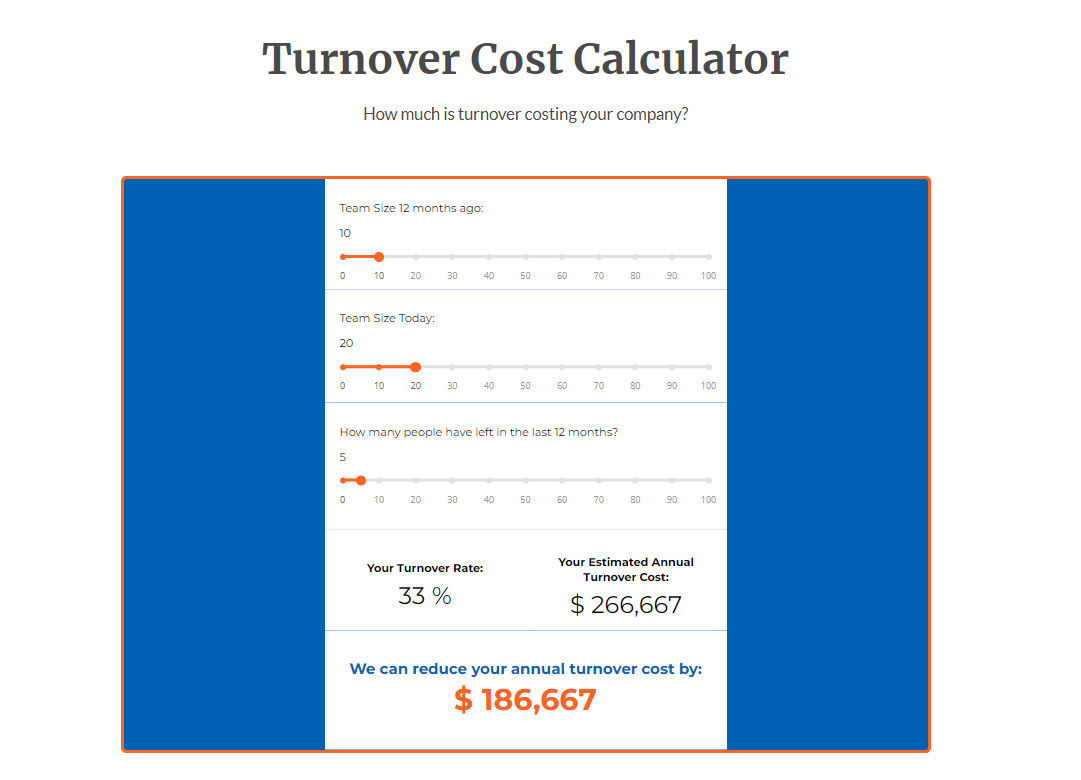As your business grows, you will inevitably experience employee turnover and associated costs.
In this video, Tom Nickalls – Founder and CEO of Castle HR, will walk you through what employee turnover cost is, how to calculate it for your company and what a “healthy” employee turnover rate looks like. (Spoiler: it’s not 0%!)
These costs aren’t always direct and obvious, but they’re real. And, unfortunately, no organization is immune to turnover… especially if you’re growing or going through a major change!
The reality is that, at its best, employee turnover is inconvenient. But at its worst, it can drain morale, efficiency and profitability!
Despite your best efforts, employee turnover may become out of hand at one point or another.
That doesn’t mean the situation is hopeless and you’re at the mercy of luck. You can reduce turnover by implementing modern HR strategies and hiring the right people.
First, however, you must understand where you are today to explore what needs to change!
What is a Normal Employee Turnover Rate?
Your employee turnover rate is the proportion of your workforce who leave in a given year.
For most SMBs, a 10% – 12% employee turnover rate is considered fairly standard.
…but it can vary! Depending on your industry, you may even creep into the 15% range. Between July 2021 and June 2022, the global turnover rate (per LinkedIn) came in at 10.6%.
Generally speaking, small growing companies experience more turnover than large, established companies, so don’t fret if your rate is higher than the ones referenced here.
In any case, knowing how to calculate your turnover rate is important!
How Do You Calculate Your Turnover Rate?
In growing organizations, people who leave their roles usually need to be replaced.
Therefore, when calculating your turnover rate, you must consider the number of people who left your organization factored against your average headcount during the last 12 months.
The good news is, you can skip the math by using our Employee Turnover Cost Calculator:
To use our calculator, you need to know the following:
- How many employees you have presently
- How many employees you had exactly a year ago
- How many people left in the past year*
*That includes people who left on their own (resigned) and those who were asked to leave (terminated or laid off).
How Can Turnover Be Costly?
It takes substantial time to interview, onboard and train a new employee.

This time could have been put to other uses had the previous person never left. That lost time may have been better spent pursuing business development opportunities (i.e., increasing revenues) or implementing efficiencies (i.e., cost-cutting).
Instead, when turnover happens, you’re investing company time to fill a position that was staffed just a short time ago.
To make matters worse, the previous employee may have left unfinished work, taken the knowledge of key processes with them or disappointed some customers before they departed.
Those are a handful of examples, but someone rarely leaves with everything they were responsible for running smoothly.
The incoming employee must ramp up and mend some of those fences – in excess, this added responsibility can be a daunting undertaking, and depending on your onboarding process, it may be overwhelming and lead to further turnover.
Essentially, we’re talking about lost time and effort and the potential that you’ll have to burden other members of your team to bridge the gap. These are a few examples of the hidden costs of employee turnover, which can add up quickly.
How Much Does Employee Turnover Cost?
As a rule, employee turnover will cost you between 25% – 200% of the salary for the role you’re replacing.
This skews lower for entry-level positions and towards the high end of that range for executives. Let’s assume an overall average of 50% for the sake of simplicity.
If a $100,000 employee resigns tomorrow, expect to spend about $50,000 worth of time and resources on lost productivity.
This could be due to dissatisfaction (outgoing person), lower team morale, recruitment and hiring costs, training time, and lost productivity during ramp-up (for the incoming person).
Is it Possible to Have Zero Employee Turnover?
Unless you’re a tiny company and only looking at a brief timeframe, probably not!
We firmly believe there should be no such thing as a 0% turnover rate. Any company claiming zero turnover is either not telling the truth or has some issues behind the scenes.
The reality is that, at times, complacency or accountability challenges will arise.
Managing those individuals out of your organization may be best in certain situations. On the other end hand, each company can only offer limited growth opportunities.
Healthy turnover is a natural side effect of employing people.
You can’t reasonably expect to be the perfect workplace for everyone all the time.
For instance, if somebody does not get the promotion they wanted, or they’re considering a new career after being in their role for many years, there’s a chance they’ll look elsewhere for work.
This isn’t always the case; conducting quarterly Modern Performance Reviews is one way to focus on growth and goals with each of your employees and keep them engaged.
But, at the end of the day, your employees have lives and ambitions outside of your control, and that’s perfectly okay.
What is ‘Healthy’ Turnover?
Consider it a red flag if your company feels like a revolving door with people quickly entering and exiting.

However, as noted above, a bit of turnover is entirely natural AND healthy!
Usually, healthy turnover refers to individuals who have thrived in their roles and are now seeking new opportunities that your company can’t offer them.
Let’s say you have three top performers on your team interested in a newly created Sales Manager position at your company.
All three of them are qualified…but the problem is that you only have one opening.
Upon promoting the most qualified of the three, you should expect a natural exit from at least one of the two who weren’t selected.
Even with further growth, you won’t have three Sales Manager roles available at any point in the near future without overstaffing the department or watering down that title.
Simply put, you may see people who desire to ‘climb the ladder’ exit amicably if they aren’t given a promotion or title they applied for. This isn’t a bad thing whatsoever; you can tell future candidates that not only did you progress one career, but two. This will enable you to continue filling your entry- and mid-level roles with highly talented individuals!
How to Improve Your Employee Turnover Costs
If your turnover rate exceeds the above averages, you have some work to do!
Don’t worry, but also, don’t ignore it…high turnover isn’t going to do you any favours! But, there are proven methods to improve this metric.
Take a snapshot of where you are today and see how much you can improve in the next 12 months. Compete against yourself, and don’t worry about anyone else.
There are a few ways you can address your employee turnover and improve it:
Revisit your Talent Acquisition Strategy
…If you don’t have a Talent Acquisition Strategy in place, it’s time to create and implement one with the help of an HR Professional.
At Castle HR, we firmly believe that when you put the Right People in the Right Seats, it’s hard NOT to be successful.
This means that if your entire hiring process (from job descriptions to interviewing) is based on your company values, you’ll be more likely to hire people who align with your goals and culture overall.

Look at your values and culture
Companies with solid values and cultures tend to retain their employees longer.
For example, retaining people for four years instead of two will reduce your turnover rate drastically!
Ultimately, culture is the glue that holds your organization together and making an effort to identify, define and communicate your culture can have a significant impact on retention.
But this won’t happen overnight. You have to be patient and work at it consistently…and, as we said above, hire (and keep) people who align with your values!
Keep everyone engaged and communicating
Employees aren’t going to feel very connected to their role or their leader if you only converse once a year.
Now more than ever, employees want frequent and actionable feedback. A well-executed Modern Performance Review will improve your organization’s productivity, engagement and retention. A solid two-way flow of communication will root out minor problems before they become big problems. Plus, your team will develop faster and go further!
![]()
(High fives all around!)
Another great way to give feedback and communicate with your team is to
- Conduct surveys -we do this quarterly at Castle HR – and take action when necessary to show your employees that you care about their feedback and review it
- Have a regular communication platform and stay true to your word if you do have an ‘open door’ policy or something else of that nature – this can be outlined in your Employee Handbook
Communicating with your team and showing them that you care is essential to building an engaged, productive and aligned team…and retaining them!
Key Turnover Takeaways
As your business grows and evolves, employee turnover is an inevitable aspect you must address.

While turnover costs may not always be apparent, they can significantly impact your company’s bottom line. It’s crucial to understand your turnover rate and its hidden costs. (Check out our Turnover Cost Calculator if you haven’t already and want to understand your turnover rate better!)
A healthy level of turnover can be expected as employees seek new opportunities and career growth.
However, when turnover becomes excessive, it’s time to take action!
You can improve employee retention and reduce turnover costs by implementing the right modern HR strategies, focusing on talent acquisition aligned with your company values, and nurturing a winning company culture.
Remember, open communication and frequent feedback are vital in building a connected and motivated team.
Conducting quarterly performance reviews and embracing a two-way flow of communication will strengthen your organization and propel your team toward success.
As you strive for excellence, don’t forget to compete against yourself and set achievable goals for reducing turnover. Investing in your employees’ happiness and professional development will undoubtedly pay off in the long run!
At Castle HR, we’re passionate about helping startups and small businesses like yours succeed.
You don’t have to do it alone if you need to improve your turnover rate. We can help enhance your employee retention strategies together and build a thriving, engaged, and committed team.
Ready to tackle your turnover challenges head-on? Book a call today!

Lyndsy has been working in the HR realm for over two years and has experience in content management, ghostwriting and copywriting. She holds a Bachelor’s in English and Cultural Studies and considers herself a lifelong learner and passionate storyteller. Regarding modern HR, Lyndsy believes businesses can stand out as ‘top destinations’ for talented people by adopting a people-centred approach and fostering a strong culture; that’s one of the reasons she was drawn to Castle HR!
